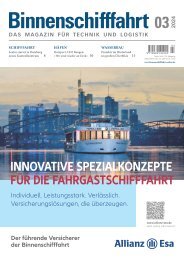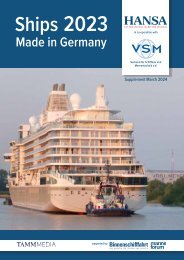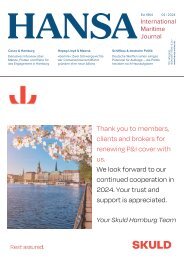HANSA 10-2020
Schiffstechnologie der Zukunft | Leichtbau | Review Compit 2020 | HANSA Engine Survey 2020 | Ihatec-Bilanz | LNG-Umbau Münsterland | Mega-Yachten & Werften | Havarie Peter Pan | Fährschifffahrt
Schiffstechnologie der Zukunft | Leichtbau | Review Compit 2020 | HANSA Engine Survey 2020 | Ihatec-Bilanz | LNG-Umbau Münsterland | Mega-Yachten & Werften | Havarie Peter Pan | Fährschifffahrt
Erfolgreiche ePaper selbst erstellen
Machen Sie aus Ihren PDF Publikationen ein blätterbares Flipbook mit unserer einzigartigen Google optimierten e-Paper Software.
Schiffstechnik | Ship Technology<br />
© OMT Torino<br />
One topic of discussion:<br />
Smart Injectors<br />
Meccaniche Torino described their new<br />
smart injectors, enabling performance<br />
monitoring and condition-based maintenance.<br />
A piezo-electric sensor inside the<br />
smart injector collects time series of control-volume<br />
pressure during each injection,<br />
a thermocouple and a current sensor<br />
record injector temperature and injector<br />
driving current.<br />
An electronic card mounted to the injector<br />
head performs the conditioning<br />
and digitalisation of the acquired signals<br />
and transmits them via a bus driven<br />
by a hub, which also provides CAN<br />
and Ethernet interfaces for the connection<br />
to the control unit for data processing.<br />
The raw data is then processed via<br />
a mix of traditional signal processing<br />
and machine learning techniques, creating<br />
»Value Added Data, VAD«. This<br />
describes the injector performance for<br />
Bert Buchholz from University of Rostock<br />
prepared a special issue of the conference<br />
© Payer<br />
each injection cycle, such as instant control-valve<br />
opening, injection start/end<br />
or opening/closing velocity of the nozzle<br />
needle. VAD are the basis for estimating<br />
Key Performance Indicators for<br />
each injector and the whole injection<br />
system. They are displayed to the engine-room<br />
crew via a web-based dashboard<br />
and transmitted to a cloud-based<br />
storage for further analysis at OMT<br />
headquarters. The actual performance<br />
can be compared with the expected behaviour<br />
of the injector showing anomalies<br />
or long-term deviations.<br />
Exhaust gas<br />
Daniel Peitz from Hug engineering, together<br />
with VTT Finland described a<br />
development project to enable a medium<br />
speed diesel engine to run in compliance<br />
with EU Stage V emission limits, outperforming<br />
US EPA Tier 4 final marine requirements,<br />
leading to an IMO ultra-low<br />
emission vessel notation. A 2 MW Anglo<br />
Belgian Corporation ABC DZC engine<br />
on a testbed is combined with a modular<br />
Hug exhaust gas aftertreatment system<br />
including a diesel particulate filter<br />
with active regeneration and a selective<br />
catalytic reduction system with the possibility<br />
to also include an oxidation catalyst.<br />
Systematic variations of the engine<br />
with this aftertreatment-setup for different<br />
operation modes led to a robust concept<br />
to achieve emissions well below EU<br />
Stage V limits.<br />
Apart from NO x which is a function of<br />
the dosed urea solution, the cycle averaged<br />
emissions, considering ageing and<br />
regeneration factors, are only <strong>10</strong>-36% of<br />
the respective threshold values. Compliance<br />
of a medium speed engine with the<br />
stringent EU Stage V emission limits was<br />
shown here for the first time.<br />
Conversion<br />
The three year experience with the »Wes<br />
Amelie«, a 1,036 TEU container feeder<br />
vessel, converted to LNG-operation,<br />
were described by Rainer Runde from<br />
Wessels Reeredei and Christian Hoepfner<br />
from Wessels Marine. An isolated<br />
9% nickel LNG-Tank was placed in void<br />
spaces in the fore-ship. The engines on<br />
board from Caterpillar/MAK and MAN<br />
were converted to LNG operation without<br />
problems. The power of the main engine<br />
was reduced from 9,000 to 7,800KW,<br />
which was still enough to reach the service<br />
speed of 17 kn. Due to the higher energy<br />
content of LNG and other positive factors<br />
the annual fuel cost for the converted ship<br />
turned out to be about 30% less compared<br />
to diesel operation. The ecological effect of<br />
the conversion is considerable: Nox -85%,<br />
Sox -95%, PM -87%, CO2 -33%. The effective<br />
reduction of the greenhouse effect is<br />
however reduced only by 5% due to Methane-slip.<br />
A methane catalyser could help<br />
here, once it is available.<br />
»Dare you…?« (Greta), RGMT <strong>2020</strong> was<br />
all about what the maritime industry can<br />
do and what it must do to reduce its footprint.<br />
Every sector has to do what is possible.<br />
We have to find the rational balance<br />
between minimisation of emissions and<br />
economic consequences.<br />
RGMT <strong>2020</strong> has shown again, mankind<br />
is inventive. Inventiveness and innovation,<br />
however, need freedom. We cannot blindly<br />
phase out fossile fuels, for instance. Possibly<br />
the best solution in the future might<br />
include fossile fuels, probably optimally<br />
combined with other fuels and with effective<br />
aftertreatment. The future is hard to<br />
predict. Not only smart injection, rather<br />
complete smart propulsion systems with<br />
self-learning engines will bring many new<br />
opportunities. We shall see.<br />
n<br />
<strong>HANSA</strong> – International Maritime Journal <strong>10</strong> | <strong>2020</strong><br />
31


















